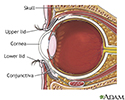Pinguecula
A pingueculum is a common, noncancerous growth of the conjunctiva. This is the clear, thin tissue that covers the white part of the eye (sclera). The growth occurs in the part of the conjunctiva that is exposed when the eye is open.
Causes
The exact cause is unknown. Long-term sunlight exposure and eye irritation may be factors. Arc-welding is a major job-related risk.
Eye irritation
Eye burning with discharge is burning, itching, or drainage from the eye of any substance other than tears.

Symptoms
A pingueculum looks like a small, yellowish bump on the conjunctiva near the cornea. It can appear on either side of the cornea. However, it more often occurs on the nose (nasal) side. The growth may increase in size over many years.
Exams and Tests
An eye exam is often enough to diagnose this disorder.
Treatment
The only treatment needed in most cases is eye drops. Keeping the eye moist with artificial tears may help prevent the area from becoming inflamed. Temporary use of mild steroid eye drops can also be helpful. Rarely, the growth may need to be removed for comfort or for cosmetic reasons.
Outlook (Prognosis)
This condition is noncancerous ( benign ) and the outlook is good.
Benign
"Benign" refers to a condition, tumor, or growth that is not cancerous. This means that it does not spread to other parts of the body. It does not ...

Possible Complications
The pingueculum may grow over the cornea and block vision. When this happens, the growth is called a pterygium . These two conditions occur under similar conditions. However, they are thought to be separate diseases.
Pterygium
A pterygium is a noncancerous growth that starts in the clear, thin tissue (conjunctiva) of the eye. This growth covers the white part of the eye (s...

When to Contact a Medical Professional
Call your health care provider if the pingueculum changes in size, shape, or color, or if you would like to have it removed.
Prevention
Things you can do that may help prevent a pingueculum or keep the problem from getting worse include:
- Keeping the eye well lubricated
- Wearing good quality sunglasses
- Avoiding eye irritants
References
Shtein RM, Sugar A. Pterygium and conjunctival degenerations. In: Yanoff M, Duker JS, eds. Ophthalmology . 4th ed. Philadelphia, PA: Elsevier Saunders; 2014:chap 4.9.
Zloty P, Belin MW. Pterygium. In: Tasman W, Jaeger EA, eds. Duane's Ophthalmology . 2013 ed. Philadelphia, PA: Lippincott Williams & Wilkins; 2013:vol 6; chap 35.
-
Eye anatomy - illustration
The cornea is the clear layer covering the front of the eye. The cornea works with the lens of the eye to focus images on the retina.
Eye anatomy
illustration
Review Date: 12/19/2016
Reviewed By: Franklin W. Lusby, MD, ophthalmologist, Lusby Vision Institute, La Jolla, CA. Also reviewed by David Zieve, MD, MHA, Medical Director, Brenda Conaway, Editorial Director, and the A.D.A.M. Editorial team.

